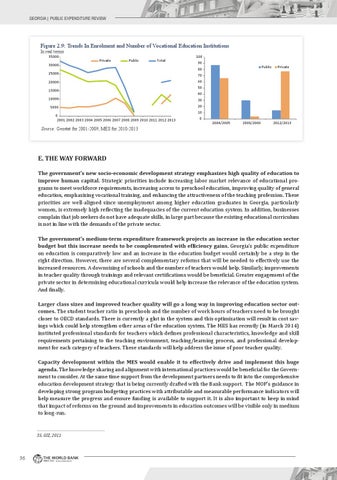GEORGIA | PUBLIC EXPENDITURE REVIEW
Figure 2.9: Trends In Enrolment and Number of Vocational Education Institutions
In real terms 35000 30000
Private
Public
Total
25000 20000 15000 10000 5000 0 2001 2002 2003 2004 2005 2006 2007 2008 2009 2010 2011 2012 2013
100 90
Public
80
Private
70 60 50 40 30 20 10 0
2004/2005
2008/2009
2012/2013
Source: Geostat for 2001-2009; MES for 2010-2013
E. THE WAY FORWARD The government’s new socio-economic development strategy emphasizes high quality of education to improve human capital. Strategic priorities include increasing labor market relevance of educational programs to meet workforce requirements, increasing access to preschool education, improving quality of general education, emphasizing vocational training, and enhancing the attractiveness of the teaching profession. These priorities are well-aligned since unemployment among higher education graduates in Georgia, particularly women, is extremely high reflecting the inadequacies of the current education system. In addition, businesses complain that job seekers do not have adequate skills, in large part because the existing educational curriculum is not in line with the demands of the private sector. The government’s medium-term expenditure framework projects an increase in the education sector budget but this increase needs to be complemented with efficiency gains. Georgia’s public expenditure on education is comparatively low and an increase in the education budget would certainly be a step in the right direction. However, there are several complementary reforms that will be needed to effectively use the increased resources. A downsizing of schools and the number of teachers would help. Similarly, improvements in teacher quality through trainings and relevant certifications would be beneficial. Greater engagement of the private sector in determining educational curricula would help increase the relevance of the education system. And finally. Larger class sizes and improved teacher quality will go a long way in improving education sector outcomes. The student teacher ratio in preschools and the number of work hours of teachers need to be brought closer to OECD standards. There is currently a glut in the system and this optimization will result in cost savings which could help strengthen other areas of the education system. The MES has recently (in March 2014) instituted professional standards for teachers which defines professional characteristics, knowledge and skill requirements pertaining to the teaching environment, teaching/learning process, and professional development for each category of teachers. These standards will help address the issue of poor teacher quality.
Capacity development within the MES would enable it to effectively drive and implement this huge agenda. The knowledge sharing and alignment with international practices would be beneficial for the Government to consider. At the same time support from the development partners needs to fit into the comprehensive education development strategy that is being currently drafted with the Bank support. The MOF’s guidance in developing strong program budgeting practices with attributable and measurable performance indicators will help measure the progress and ensure funding is available to support it. It is also important to keep in mind that impact of reforms on the ground and improvements in education outcomes will be visible only in medium to long-run. 35. GIZ, 2011
36
